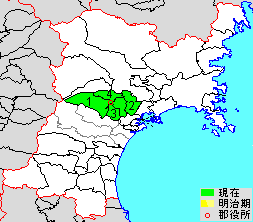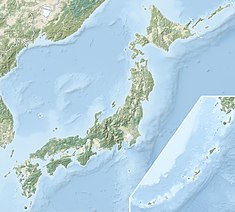
The Nathpa Jhakri Dam is a concrete gravity dam on the Sutlej river in Himachal Pradesh, India. The primary purpose of the dam is hydroelectric power production and it supplies a 1,500 megawatts (2,000,000 hp) underground power station with water. Before reaching the power station, water is diverted through a 27.4 km (17 mi) headrace tunnel. Construction on the project began in 1993 and it was complete in 2004. The last two of the 250 megawatts (340,000 hp) Francis turbine-generators went online in March 2004. It is owned by SJVN Ltd
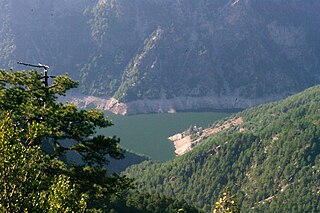
Berke Dam is concrete arch-gravity dam built on the Ceyhan river in southern Turkey. There is a hydroelectric power plant, established in 2001 at the dam, with a power output of 510 MW.

Mattupetty Dam, near Munnar in Idukki District, is a storage Concrete Gravity dam built in the mountains of Kerala, India to conserve water for hydroelectricity. It has been a vital source of power yielding along with other such dams, huge revenue to the states. The large amount of perennially available water allows wild animals and birds to flourish. However salinity caused by irrigation and water-logging are of concern to environmentalists.

Sasogawa Dam is a multi-purpose dam located in the city of Ōno in Fukui Prefecture. Japan. The dam and its reservoir are located within Okuetsu Kōgen Prefectural Natural Park.

The Shin'inotani Dam is a dam in the city of Hida, Gifu Prefecture, Japan located on the Takahara River, part of the Jinzū River system. The dam is a concrete gravity dam with a height of 56 meters, and is operated by the Hokuriku Electric Power Company. The reservoir created is used by hydroelectric power generation for a total of 56,900 kW. The dam was completed in 1963.

Honna Dam is a gravity dam on the Tadami River in Kaneyama, Fukushima Prefecture, Japan. It was constructed between 1952 and 1954 for the purpose of hydroelectric power generation. It supplies a 78 MW power station with water.

Gosho Dam is a multipurpose dam on the Shizukuishi River, a branch of the Kitakami River in Morioka, Iwate Prefecture, Japan, completed in 1981.

The Hayachine Dam is a multi-purpose dam on the Hienuki River, a branch of the Kitakami River, located in the city of Hanamaki, Iwate Prefecture in the Tōhoku region of northern Japan. It managed by Hanamaki Civil Engineering Center, Minami Kunisaki Promotion Department, and is a gravity-type concrete dam with a bank height of 73.5 meters.

Yuda Dam (湯田ダム) is a multipurpose dam located in the town of Nishiwaga, Iwate, in the Tohoku region of northern Japan. Completed in 1964, it is managed by the Tohoku Regional Development Bureau of the Ministry of Land, Infrastructure and Transport. Located on the Waga River, a branch of the Kitakami River, it is the third largest of the dams built as part of the Kitakami Area Comprehensive Development Plan (KVA). The dam creates Lake Kinshu, a popular sightseeing spot.

Misedani Dam is a multipurpose concrete Arch-gravity dam in located in Ōdai, Mie Prefecture, Japan. completed in 1966. The dam is one of several crossing the Miyagawa River, and was intended for hydroelectric power generation, and for the supply of industrial water to the Ise Bay industrial region.
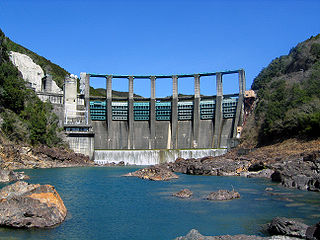
The Nanairo Dam is a concrete gravity-arch dam located in Kumano, Mie Prefecture, Japan. The dam crosses the Kitayama River, a tributary of the Kumano River near the border of Mie Prefecture with Wakayama Prefecture.

Naruko Dam is a concrete gravity-arch dam in the city of Ōsaki, Miyagi Prefecture, Japan, completed in 1958 by Kajima Corporation. The dam is located on the Eaigawa, the former main course of the Kitakami River.

The Longyangxia Dam is a concrete arch-gravity dam at the entrance of the Longyangxia canyon on the Yellow River in Gonghe County, Qinghai Province, China. The dam is 178 metres (584 ft) tall and was built for the purposes of hydroelectric power generation, irrigation, ice control and flood control. The dam supports a 1,280 MW power station with 4 x 320 MW generators that can operate at a maximum capacity of 1400 MW. Controlling ice, the dam controls downstream releases to reservoirs lower in the river, allowing them to generate more power instead of mitigating ice. Water in the dam's 24.7 billion m3 reservoir provides irrigation water for up to 1,000,000 hectares of land.

Stave Falls Dam is a dual-dam power complex on the Stave River in Stave Falls, British Columbia, Canada. The dam was completed in 1912 for the primary purpose of hydroelectric power production. To increase the capacity of Stave Lake, the dam was raised in 1925 and the Blind Slough Dam constructed in an adjacent watercourse 500 m (1,600 ft) to the north, which was the site of the eponymous Stave Falls. In 2000, the dam's powerhouse was replaced after a four-year upgrade. The powerhouse was once British Columbia's largest hydroelectric power source and is a National Historic Site of Canada.
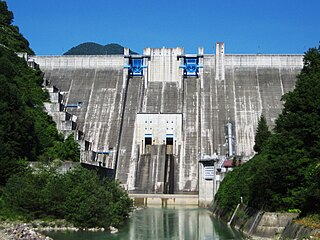
The Ōmachi Dam is a concrete gravity dam on the Takase River just west of Ōmachi in Nagano Prefecture, Japan. Construction of the dam began in 1975 and it was completed in 1985. The primary purpose of the dam is water supply and it also supports a 13 MW hydroelectric power station. It is owned by TEPCO.

The Daguangba Dam is a multi-purpose dam on the Changhua River in Hainan Province, China. It is located 35 km (22 mi) east of Dongfang. As the primary component of the Daguangba Multipurpose Project, the dam was constructed between 1990 and 1995. It serves to provide water for both hydroelectric power generation and agriculture. It supports a 240 MW power station and supplies water for the irrigation of 12,700 ha. It is also the largest dam and hydroelectric power station in Hainan.

Ghatghar Dam refers to two associated gravity dams built using roller-compacted concrete, the first use in India. They are situated in Ghatghar village in Ahmednagar district Maharashtra, India. Both dams create a lower and upper reservoir for the 250 MW pumped-storage hydroelectric power station. The upper Ghatghar dam is 15 m (49 ft) tall and on the Pravara River, a tributary of Godavari river. The lower Ghatghar dam is 86 m (282 ft) tall and located on the Shahi Nalla which is a tributary of Ulhas River to the south west of the upper reservoir in a steep valley. The hydro power project diverts Godavari river basin water outside the basin area to a west flowing river of Western ghats.

The Pembelik Dam is a gravity dam on the Peri River, in Karakoçan district of Elazığ Province, Turkey. Its primary purpose is hydroelectric power generation and is the fourth dam in the Peri River cascade. Construction on the dam began in 2009 and its two generators were commissioned in February/March 2015. The 88 m (289 ft) tall roller-compacted concrete dam faced opposition from locals and construction was briefly suspended in 2014. It is owned and operated by Limak Energy and Bilgin Energy.

The Burç Bendi Dam is a gravity dam on the Göksu River, near the village of Burç in Adıyaman district, Adıyaman Province, Turkey. Its primary purpose is hydroelectric power generation and it supports a 27.9 MW run-of-the-river power station. Construction on the dam began in January 2008 and it was fully operational by 3 November 2010. The 57 m (187 ft) tall concrete dam withholds a reservoir of 26,600,000 m3 (21,600 acre⋅ft). Water is diverted through a 536 m (1,759 ft) long tunnel to the power station downstream which contains three 9.3 vertical Kaplan turbine-generators. It is owned and operated by ČEZ Group.


